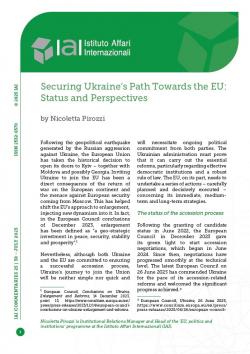Securing Ukraine’s Path Towards the EU: Status and Perspectives
Following the geopolitical earthquake generated by the Russian aggression against Ukraine, the European Union has taken the historical decision to open its doors to Kyiv – together with Moldova and possibly Georgia. Inviting Ukraine to join the EU has been a direct consequence of the return of war on the European continent and the menace against European security coming from Moscow. This has helped shift the EU’s approach to enlargement, injecting new dynamism into it. In fact, in the European Council conclusions of December 2023, enlargement has been defined as “a geo-strategic investment in peace, security, stability and prosperity”.[1]
Nevertheless, although both Ukraine and the EU are committed to ensuring a successful accession process, Ukraine’s journey to join the Union will be neither simple nor quick and will necessitate ongoing political commitment from both parties. The Ukrainian administration must prove that it can carry out the essential reforms, particularly regarding effective democratic institutions and a robust rule of law. The EU, on its part, needs to undertake a series of actions – carefully planned and decisively executed – concerning its immediate, medium-term and long-term strategies.
The status of the accession process
Following the granting of candidate status in June 2022, the European Council in December 2023 gave its green light to start accession negotiations, which began in June 2024. Since then, negotiations have progressed smoothly at the technical level. The latest European Council on 26 June 2025 has commended Ukraine for the pace of its accession-related reforms and welcomed the significant progress achieved.[2]
Meanwhile, in May, the European Commission has assessed that the first negotiations cluster related to the so-called ‘fundamentals’ of shared values, rule of law, independent judiciary and human rights is ready to be opened.[3] However, Hungary has then blocked the opening of the cluster, primarily over complaints about discrimination against ethnic-Hungarian minorities in Ukraine, and lately referring to the results of a national self-styled referendum on Ukraine’s EU accession, according to which 95 per cent of surveyed citizens – approximately around 29 per cent of Hungary’s eligible electorate – are against it.[4] This has stopped the process at the political level, wiping out the EU and Ukraine’s initial optimistic timeline for opening three of the six chapters – related to fundamentals, internal market and external relations – by the first semester of 2025, under the rotating Polish Presidency of the EU Council.[5]
On the Ukrainian side, reforms are ongoing in different fields to meet the EU’s criteria and advance the accession process. In the rule of law domain, efforts are focused on strengthening legal institutions, further improving the judiciary, enhancing the effectiveness of anti-corruption policy, improving human rights protection, and reinforcing security and law enforcement.[6] Kyiv has also embarked on an ambitious public administration reform for further modernisation, digitalisation and improved accessibility of public services.[7]
Ukraine has also worked to advance its energy transition in order to align with EU standards. Ukraine’s National Energy and Climate Plan (NECP) targets a full coal phase-out by 2035. It also aims to improve energy efficiency, enhance energy security by limiting overdependence on single suppliers, and foster innovation through smart grids and green technologies.[8] Kyiv also finalised a Roadmap and Action Plans for the green recovery and transformation of the country’s food industry, aiming to guiding its transition toward a more climate-resilient, competitive and EU-aligned model.[9] Nevertheless, the reform process remains fraught with challenges, many of which are intensified by the ongoing war.
Supporting Ukraine’s accession path through economy and security
Securing Ukraine’s path towards the EU means first and foremost to help Kyiv address its most urgent security needs. The second Trump presidency has put additional pressure on the EU to provide adequate support for Ukraine’s resistance against the Russian invasion, in particular through sanctions and by providing military hardware. If the EU wants to remain a credible partner for Ukraine – despite the US’s declared disengagement – it has to keep a united stance and put additional pressure on President Putin to agree on an unconditional ceasefire and engage in meaningful negotiations. Political unity has been preserved so far, despite attempts to jeopardise it mainly coming from Budapest. In fact, in the latest European Council’s meetings, conclusions on Ukraine had to be adopted at 26, without Hungary.[10]
Notably, even if the EU’s sectoral sanctions against Russia have been extended for another six months, Hungary and Slovakia have blocked the adoption of the 18th package of restrictive measures, declaredly due to energy security concerns. This new package would include a transaction ban for EU operators regarding Nord Stream 1 and Nord Stream 2, a lower price cap on oil from 60 to 45 dollars per barrel, sanctions on refined fuel imports from third countries, and penalties on the Nord Stream pipeline infrastructure, but also a full transaction ban on the Russian banking sector and financial operators in third countries that finance trade to Russia, as well as widening export bans and controls to tackle circumvention practices.[11]
Furthermore, the EU has to mobilise additional and collective financial capacity to equip Kyiv with the necessary weapons to counter the ongoing Russian offensive. Since March, the European contributions (led by the Nordics and the UK) have filled the gap left by the US,[12] but there are uncertainties about the future. Urgent needs include, in particular, the delivery of air defence and anti-drone systems, and large-calibre ammunition.
In the medium term, hopefully after a successful defence of Ukraine followed by the beginning of a negotiated settlement with Russia from an advantageous position, the greatest challenge for Europe would be to ensure the reconstruction of the battered country. It has been calculated that Ukraine would need 524 billion dollars over the next decade to get back on its feet.[13] And most of the burden would have to be borne by the EU. The Union is Ukraine’s largest donor and is committed to providing Kyiv with regular and predictable financial support. In 2025, the European Union will provide Ukraine with 30.6 billion euros, of which 3.5 billion have already been disbursed under the Ukraine Facility. In addition, 7 billion euros have been allocated under the G7-led Extraordinary Revenue Acceleration (ERA) loans initiative, which is repaid by the windfall profits stemming from immobilised Russian assets[14] and overall aims to provide approximately 45 billion euros in financial support to Ukraine.
This commitment would require a mobilisation of funds well beyond the European governments’ capacity. One way to do this is to involve a broad range of stakeholders, including international organisations and financial institutions, business and civil society organisations, and to rely on public-private partnerships. This is the approach behind the Ukraine Recovery Conference to be held in Rome on 10-11 July 2025.
But Ukraine’s accession to the EU will likely be a long-lasting process that requires the Union to strategise long-term. First of all, the EU would need to give Ukraine adequate security guarantees until its accession, when it will be covered by the mutual defence clause provided by article 42(7) of the Treaty of the European Union. In the meantime, Kyiv has to be put in the position to defend itself effectively. This could be done through a reinforced European Peace Facility to fund Kyiv’s defence capacities, but also through civilian and military missions with mandates that include the advisory, training, and equipping of Ukrainian security and military forces and relevant institutions and agencies.
Preparing the EU for Ukraine
Simultaneously, if the EU aims to turn Ukraine’s accession into a success story and learn from past mistakes, it must undertake a challenging reform process concerning both its enlargement policy and internal operations.
With respect to the enlargement policy, integrating Ukraine (and potentially other nations from the Western Balkans and Eastern neighbourhood) will require greater flexibility. Possible actions might include granting access to the European single market as an initial step toward EU membership, providing progressive access to the EU’s structural funds during the pre-accession phase or allowing Ukrainian representatives to participate in European institutions.
From an internal perspective, in addition to institutional reforms, expanding the EU to Ukraine raises issues related to the redistribution of the EU budget and funding for both the Cohesion Policy and the Common Agricultural Policy (CAP). In fact, Ukraine’s membership would result in a decrease in the EU’s GDP per capita, necessitating adjustments to budget allocations, including Cohesion Funds. Notably, Kyiv would emerge as the main beneficiary of the CAP, which allocates funds based on the area of cultivated land, amounting to approximately 85 billion euros, according to estimates from Bruegel.[15] Therefore, reforming budgetary regulations, particularly concerning the CAP, appears essential.
In all, securing Kyiv’s path towards the EU undoubtedly entails a number of challenges for both sides, including progressing in the reform process to align the country with EU standards, equipping it economically and militarily to sustain the war effort with a view to reaching a just and sustainable peace as well as developing a plan for post-war reconstruction. The enlargement process, moreover, will put additional pressure on the EU to implement the necessary reforms in its decision-making system and sectoral policies.
At the same time, Ukraine’s European future is an essential element for European security. Kyiv’s integration is the best and surest way to avoid having a perennial, dangerous competition with a revanchist Russia over influence on Ukraine, or to avoid the risk of Ukraine becoming an unmanageable and extremely dangerous failed State in the neighbourhood. Moreover, the reconstruction efforts also make sense from the economic point of view, as they offer the opportunity for expanding and modernising the EU’s business sector in all areas, from energy to technology and agriculture. The effort of integrating Ukraine into the EU, therefore, is soundly justified from all points of view. It will, however, require unwavering commitment, adequate resources and long-term vision.
Nicoletta Pirozzi is Institutional Relations Manager and Head of the ‘EU, politics and institutions’ programme at the Istituto Affari Internazionali (IAI).
[1] European Council, Conclusions on Ukraine, Enlargement and Reforms, 14 December 2023, point 13, https://www.consilium.europa.eu/en/press/press-releases/2023/12/14/european-council-conclusions-on-ukraine-enlargement-and-reforms.
[2] European Council, Ukraine, 26 June 2025, https://www.consilium.europa.eu/en/press/press-releases/2025/06/26/european-council-26-june-2025-ukraine.
[3] “Ukraine Ready to Open First Cluster of EU Accession Chapters, Says Commissioner Kos”, in The New Union Post, 20 May 2025, https://wp.me/pg5F2z-14t.
[4] Alexandra Brzozowski, “Hungary Holds the Line on Ukraine’s EU Bid Veto after Negative Referendum”, in Euractiv, 26 June 2025, https://www.euractiv.com/?p=2271043.
[5] Simone De La Feld, “Von der Leyen Pushes to Open All Chapters for Ukraine’s EU Membership in 2025 but Orbán’s Patriots Stand in the Way”, in Eunews, 7 May 2025, https://www.eunews.it/en/?p=425910.
[6] Amanda Paul and Svitlana Taran, “Ukraine’s Road to the EU: Getting Fit to Open Negotiating Clusters”, in EPC Commentaries, 28 February 2025, https://www.epc.eu/publication/Ukraines-road-to-the-EU-Getting-fit-to-open-negotiating-clusters-626b50/.
[7] “Development of the Public Administration Reform Roadmap: Key Priorities”, in Par.in.ua platform, 11 February 2025, https://par.in.ua/en/information/publications/408.
[8] Ukrainian Ministry of Economy, Ukraine Approves National Energy and Climate Plan on the Day of the Start of EU Accession Negotiations, 25 June 2024, https://www.kmu.gov.ua/en/news/ukraina-zatverdyla-natsionalnyi-plan-z-enerhetyky-ta-klimatu-v-den-pochatku-peremovyn-pro-vstup-do-ies.
[9] Ukrainian Ministry of Agrarian Policy and Food, Roadmap for the Green Recovery and Transformation of the Ukrainian Food Industries, March 2024, https://www.unido.org/sites/default/files/unido-publications/2025-01/Roadmap-for-Green-Recovery-and-Transformation-of-Ukrainian-Food-Industries_1.pdf; and Action Plans for the Green Recovery and Transformation of the Ukrainian Food Industries, March 2024, https://www.unido.org/sites/default/files/unido-publications/2025-01/Action-Plans-for-Green-Recovery-and-Transformation-of-Ukrainian-Food-Industries.pdf.
[10] European Council, Ukraine, cit.
[11] European Commission, Statement by President von der Leyen with HR/VP Kallas on the 18th Package of Sanctions against Russia, 10 June 2025, https://ec.europa.eu/commission/presscorner/detail/en/statement_25_1471.
[12] Kiel Institute, Ukraine Support: Europe Largely Fills the US Aid Withdrawal, Lead by the Nordics and the UK, 16 June 2025, https://www.ifw-kiel.de/publications/news/ukraine-support-europe-largely-fills-the-us-aid-withdrawal-lead-byn-the-nordics-and-the-uk.
[13] World Bank, Updated Ukraine Recovery and Reconstruction Needs Assessment Released, 25 February 2025, https://www.worldbank.org/en/news/press-release/2025/02/25/updated-ukraine-recovery-and-reconstruction-needs-assessment-released.
[14] European Council, Ukraine, cit.
[15] Zsolt Darvas et al., “The Impact on the European Union of Ukraine’s Potential Future Accession”, in Bruegel Reports, 11 April 2024, p. 6 and 50-51, https://www.bruegel.org/node/9881.
-
Dati bibliografici
Roma, IAI, luglio 2025, 5 p. -
In:
-
Numero
25|38




